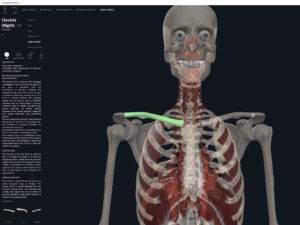Anatomy & Physiology: Bones—Clavicle.
Structure.
- The clavicle is long, flattish, and has a slight S-shape curve to it (but it isn’t as pronounced as one may think).
- Easily observed with the naked eye and also easily palpateable.
- Sternal end: the medial end of the clavicle articulates with the manubrium. The sternal end may be identifed as it is “blunt” and fairly straight-edged as compared to the acromial end.
- Acromial end: the lateral and more rounded end (almost spoon-like shape) that articulates with the scapula.
- Superior view: (bird’s eye view looking down) from the medial/sternal end, the clavicle is slightly concave anteriorly. Proceeding laterally towards the acromial end, the curve changes to slightly convex anteriorly. The superior surface both appears and feels a bit smoother than the inferior side.
- Inferior view: the bone is rougher.
Function.
Clinical Significance.
- The midregion of the clavical where one part of the “S” curve transitions to the other is the weakest point of the clavical. Fractures often occur in this region.
- Falling poorly (i.e. with arms outstretched) and a superior-anterior blow may fracture the clavicle.
References
Biel, A. (2015). Trail guide to the body: A hands-on guide to locating muscles, bones and more.
Cedars-Sinai. (2018). Vertebrae of the spine. Retrieved from https://www.cedars-sinai.org/health-library/diseases-and-conditions/v/vertebrae-of-the-spine.html
Jenkins, G., & Tortora, G. J. (2012). Anatomy and Physiology: From Science to Life, 3rd Edition International Stu. John Wiley & Sons.
Muscolino, J. E. (2017). The muscular system manual: The skeletal muscles of the human body.


